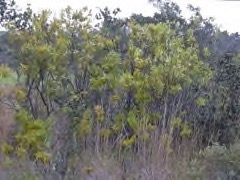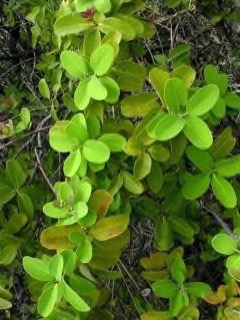 |
|
Forest & Kim Starr wikimedia.org |
 |
| David Eickhoff from Pearl City, Hawaii wikimedia.org |
Translate this page:
Summary
Santalum paniculatum or commonly known as Mountain Sandalwood or ?Iliahi is a small tree or shrub growing about 3-10m in height and can be found in the Pacific. It has greenish blue leaves that are narrowly oval. The flowers are small, located at the ends of branches. The fruit is fleshy, black or purple when ripe, and comprised of a single seed. When mixed with other plant, it is used in the treatment of venereal diseases, severe sores, dandruff, and head lice. Like other genus in the Santalum species, the seed is edible but is more valued for propagation than as food. The plant also yields highly-valued essential oil which is used in cosmetics, perfumery, incense sticks, aromatherapy, etc. The wood can be used for carving, arts, handicraft, and decorative furniture.
Physical Characteristics

 Santalum paniculatum is an evergreen Tree growing to 7.5 m (24ft) by 7.5 m (24ft) at a slow rate.
Santalum paniculatum is an evergreen Tree growing to 7.5 m (24ft) by 7.5 m (24ft) at a slow rate.
See above for USDA hardiness. It is hardy to UK zone 10. The flowers are pollinated by Bees, Insects.
Suitable for: light (sandy) and medium (loamy) soils, prefers well-drained soil and can grow in nutritionally poor soil. Suitable pH: mildly acid, neutral and basic (mildly alkaline) soils and can grow in very acid and saline soils.
It can grow in semi-shade (light woodland) or no shade. It prefers dry soil and can tolerate drought. The plant can tolerate maritime exposure.
UK Hardiness Map
US Hardiness Map
Synonyms
No synonyms are recorded for this name.
Plant Habitats
Edible Uses
Edible Parts: Seed
Edible Uses:
Seed - tasty[312 ]. The scarcity of seeds, and their high value for propagation, makes their use as food somewhat inappropriate[312 ].
References More on Edible Uses
Medicinal Uses
Plants For A Future can not take any responsibility for any adverse effects from the use of plants. Always seek advice from a professional before using a plant medicinally.
Parasiticide
A drink made from finely ground powdered heartwood, mixed with other plants, followed by laxative was used in curing venereal diseases in both males and females[312 ]. The powdered heartwood is combined with Piper methysticum, Eugenia reinwardtiana, Bobea species and Alphitonia ponderosa[417 ]. For treating severe sores, the powdered wood is combined with the wood of Melicope hawaiensis and Bobea species, combined with Piper methysticum and the bark of Syzygium malaccense[417 ]. A shampoo made from a leaf infusion, sometimes combined with the ashes of Myoporum sandwicense, has been used for curing dandruff and eliminating head lice[312 ].
References More on Medicinal Uses
The Bookshop: Edible Plant Books
Our Latest books on Perennial Plants For Food Forests and Permaculture Gardens in paperback or digital formats.

Edible Tropical Plants
Food Forest Plants for Hotter Conditions: 250+ Plants For Tropical Food Forests & Permaculture Gardens.
More

Edible Temperate Plants
Plants for Your Food Forest: 500 Plants for Temperate Food Forests & Permaculture Gardens.
More

More Books
PFAF have eight books available in paperback and digital formats. Browse the shop for more information.
Shop Now
Other Uses
Cosmetic Essential Fuel Hair Incense Parasiticide Repellent Soap making Wood
Other Uses: A high quality essential oil is obtained from the heartwood. This oil was traditionally used to a limited extent to scent coconut oil (for application to the hair and body) and cultural artifacts such as tapa cloth. Today, the oil is highly valued for use in perfumery, cosmetics, incense sticks, aromatherapy etc[312 ]. A mixture of heartwood and sapwood is powdered and made into incense or joss sticks which are used in eastern religious ceremonies. Sawdust, wood shavings from carving, or wood residue after oil distillation may be used[312 ]. The highest value sandalwood is used for carving religious statues and objects, handicrafts, art, and decorative furniture. Larger basal pieces and roots are preferred for carving. In Hawaii, sandalwood is sometimes used to make musical instruments such as the musical bow[312 ]. The wood has sometimes been used for fuel, but does not make a useful charcoal[312 ]. The wood has usually been added in small amounts to a fire for its aromatic scent and as a mosquito repellent[312 ]. The wood is rarely used for traditional purposes nowadays because of its scarcity and its very high cash value. However, it has been used for making canoe paddles, carvings, cultural purposes, medicine, and was burnt as an insect repellent[312 ]. The heartwood was powdered and used to scent coconut oil, or sprinkled over new tapa cloth to perfume it and make it waterproof[312 ].
Special Uses
Scented Plants
References More on Other Uses
Cultivation details
Santalum paniculatum is a plant of moderate elevations in the Hawaiian Islands, where it can be found at elevations from 450 - 2,500 metres. It is usually found in moderately dry to wet habitats in areas where there is a 2 - 5 month dry season and no frosts[312 ]. Prefers a position with moderate side shade, but little overhead shade; it grows poorly in deeper shade, but can do well in full sun if attached to a suitable host[312 ]. Tolerant of a range of soil conditions, including infertile and shallow soils, but grows best in a light to medium, well-drained soil[312 ]. Prefers a neutral to slightly alkaline soil with a pH 6.1 - 7.4, but can tolerate 4 - 7.4[312 ]. Established plants are able to survive a long dry season (up to 5 - 6 months) when attached parasitically to suitably drought_tolerant host plants[312 ]. Although the tree has become much less common in its native habitat due to the ravages of introduced grazing animals and rats, the tree does actually have the potential to become invasive, spreading by seeds and root suckers. However, this has not been seen as a problem in the past, mainly due to the high value of the wood and the ease with which they can be shaded out by taller trees[312 ]. A slow-growing species, showing annual height increases of 30 - 70cm a year when young. Growth is faster in fertile soils but the tree is then at risk of being shaded out or overtopped by taller, faster growing trees on such sites[312 ]. Under good conditions, plants begin flowering from an early age, typically about 3 - 4 years, but heavy flowering and fruiting may take 7 - 10 years[312 ]. Trees can flower and produce fruit throughout the year, usually with two peaks. The flowers produce a sweet fragrance[312 ]. Trees produce root suckers, especially if cut down, when a ring of suckers will often appear several metres away from the original stump[312 ]. A semi-parasitic plant, obtaining some of its nutriment from the roots of other plants[144 ]. The plant has green leaves containing chlorophyll, and is thus able to photosynthesize - it relies on host plants only for water and soil nutrients, not for sugars, which it can produce itself[343 ]. It normally has more than one host at a time[343 ]. In the field, seedlings should be planted near potential host plants[337 ]. Seedlings are generally planted within existing vegetation near potentially suitable hosts[337 ]. Success is generally good, especially in locations where seedlings can be watered occasionally and weed competition is controlled[337 ]. Periodic trimming of the secondary host may benefit seedlings[337 ]. Flowering Time: Mid Summer Late Summer/Early Fall Mid Fall. Bloom Color: Pale Green Cream/Tan.
References Carbon Farming Information and Carbon Sequestration Information
Temperature Converter
Type a value in the Celsius field to convert the value to Fahrenheit:
Fahrenheit:
The PFAF Bookshop
Plants For A Future have a number of books available in paperback and digital form. Book titles include Edible Plants, Edible Perennials, Edible Trees,Edible Shrubs, Woodland Gardening, and Temperate Food Forest Plants. Our new book is Food Forest Plants For Hotter Conditions (Tropical and Sub-Tropical).
Shop Now
Plant Propagation
Seed - it has a fairly short viability and so is best sown as soon as it is ripe in a shady position in trays in a nursery. The optimum temperature for germination is between 28 - 31°c[312 ]. Making a small nick in the seedcoat, without damaging the embryo, can help to speed up germination rates. Germination rates can vary, with up to 90% of seeds sprouting within three weeks when sown fresh and treated with a nick. Prick out the seedlings into individual containers when large enough to handle, perhaps placing a host plant in the pot at the same time. Gradually increase light levels as the plant grows until it is compatible with the plant's intended destination. Plant out when around 20 - 25cm tall[312 ]. Container-grown plants need to be planted out close to a host tree by the time they are 6 months old[312 ].
Other Names
If available other names are mentioned here
Native Range
PACIFIC: United States (Hawaii)
Weed Potential
Right plant wrong place. We are currently updating this section.
Please note that a plant may be invasive in one area but may not in your area so it's worth checking.
Conservation Status
IUCN Red List of Threatened Plants Status : This taxon has not yet been assessed

Growth: S = slow M = medium F = fast. Soil: L = light (sandy) M = medium H = heavy (clay). pH: A = acid N = neutral B = basic (alkaline). Shade: F = full shade S = semi-shade N = no shade. Moisture: D = dry M = Moist We = wet Wa = water.
Now available:
Food Forest Plants for Mediterranean Conditions
350+ Perennial Plants For Mediterranean and Drier Food Forests and Permaculture Gardens.
[Paperback and eBook]
This is the third in Plants For A Future's series of plant guides for food forests tailored to
specific climate zones. Following volumes on temperate and tropical ecosystems, this book focuses
on species suited to Mediterranean conditions—regions with hot, dry summers and cool, wet winters,
often facing the added challenge of climate change.
Read More
Expert comment
Author
Hook. & Arn.
Botanical References
Links / References
For a list of references used on this page please go here
A special thanks to Ken Fern for some of the information used on this page.
Readers comment
| Add a comment |
|
If you have important information about this plant that may help other users please add a comment or link below. Only comments or links that are felt to be directly relevant to a plant will be included. If you think a comment/link or information contained on this page is inaccurate or misleading we would welcome your feedback at [email protected]. If you have questions about a plant please use the Forum on this website as we do not have the resources to answer questions ourselves.
* Please note: the comments by website users are not necessarily those held by PFAF and may give misleading or inaccurate information.
To leave a comment please Register or login here All comments need to be approved so will not appear immediately.
|
Subject : Santalum paniculatum
|
|
|
|